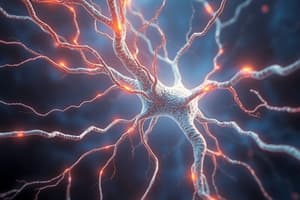Podcast
Questions and Answers
What best describes the primary function of axo-somatic synapses?
What best describes the primary function of axo-somatic synapses?
- To provide significant synaptic plasticity for learning and memory.
- To control whether a postsynaptic neuron will fire an action potential. (correct)
- To enhance the frequency of action potentials through excitatory neurotransmitters.
- To modulate the release of neurotransmitters at axon terminals.
How do axo-axonic synapses primarily affect neurotransmitter release?
How do axo-axonic synapses primarily affect neurotransmitter release?
- By directly assisting in the synthesis of neurotransmitters.
- By enhancing or inhibiting the release of neurotransmitters from the postsynaptic axon terminal. (correct)
- By mediating changes in ion channel conductance at the postsynaptic membrane.
- By changing the electrical potential across the cell body of the postsynaptic neuron.
What is a characteristic of the signal strength in axo-somatic synapses?
What is a characteristic of the signal strength in axo-somatic synapses?
- Signals degrade rapidly before reaching the axon hillock.
- They can reach the axon hillock with less decrement than other types. (correct)
- The signals are completely blocked before reaching the postsynaptic neuron.
- They are less efficient compared to axo-dendritic synapses.
Which neurotransmitter is primarily associated with the inhibitory function of axo-somatic synapses?
Which neurotransmitter is primarily associated with the inhibitory function of axo-somatic synapses?
What role does spatial exclusion play in axo-axonic synapses?
What role does spatial exclusion play in axo-axonic synapses?
What is the primary role of the axon hillock in a neuron?
What is the primary role of the axon hillock in a neuron?
Which of the following accurately describes axon collaterals?
Which of the following accurately describes axon collaterals?
What is the function of the myelin sheath?
What is the function of the myelin sheath?
What is contained within axon terminals?
What is contained within axon terminals?
How does an action potential propagate along an axon?
How does an action potential propagate along an axon?
What constitutes a synapse?
What constitutes a synapse?
What is axonal transport primarily responsible for?
What is axonal transport primarily responsible for?
What is the primary motor protein responsible for retrograde transport in neurons?
What is the primary motor protein responsible for retrograde transport in neurons?
What contributes to the nervous system's Total Metabolic Rate (TMR)?
What contributes to the nervous system's Total Metabolic Rate (TMR)?
Which of the following describes the mechanism used by Dynein for movement along microtubules?
Which of the following describes the mechanism used by Dynein for movement along microtubules?
What is the effect of colchicine on microtubules?
What is the effect of colchicine on microtubules?
Which drug is known for aggregating tubulin and leading to depolymerization?
Which drug is known for aggregating tubulin and leading to depolymerization?
What happens to alpha motor neurons as a result of tetanus toxin action?
What happens to alpha motor neurons as a result of tetanus toxin action?
What role does ATP play in the functioning of Dynein motor proteins?
What role does ATP play in the functioning of Dynein motor proteins?
Which diseases are mentioned as being associated with impaired axonal transport?
Which diseases are mentioned as being associated with impaired axonal transport?
How do drugs that affect microtubule assembly typically affect the nervous system?
How do drugs that affect microtubule assembly typically affect the nervous system?
What does retrograde transport in neurons refer to?
What does retrograde transport in neurons refer to?
What is the directionality of Dynein movement along microtubules?
What is the directionality of Dynein movement along microtubules?
What is the primary direction of anterograde transport in neurons?
What is the primary direction of anterograde transport in neurons?
Which motor protein is primarily responsible for anterograde transport?
Which motor protein is primarily responsible for anterograde transport?
What characteristic of kinesin's heavy chains allows it to move along microtubules?
What characteristic of kinesin's heavy chains allows it to move along microtubules?
What happens to a kinesin motor domain when it binds ATP?
What happens to a kinesin motor domain when it binds ATP?
Which type of cargo is typically transported retrogradely in neurons?
Which type of cargo is typically transported retrogradely in neurons?
What role do the light chains of kinesin play?
What role do the light chains of kinesin play?
How does kinesin 'walk' along the microtubules?
How does kinesin 'walk' along the microtubules?
Which of the following is NOT involved in anterograde transport?
Which of the following is NOT involved in anterograde transport?
What initiates the movement of kinesin along the microtubule?
What initiates the movement of kinesin along the microtubule?
What process is critical for the survival and function of neurons in terms of transport?
What process is critical for the survival and function of neurons in terms of transport?
What is the primary role of dendritic arbors in neurons?
What is the primary role of dendritic arbors in neurons?
Which type of neuron has a cell body located between dendritic arbors and axon terminals?
Which type of neuron has a cell body located between dendritic arbors and axon terminals?
What distinguishes pseudounipolar neurons from other types of neurons?
What distinguishes pseudounipolar neurons from other types of neurons?
What function do projection neurons typically fulfill?
What function do projection neurons typically fulfill?
Which of the following best describes interneurons?
Which of the following best describes interneurons?
Where are bipolar neurons commonly found?
Where are bipolar neurons commonly found?
What is the role of neurites in neurons?
What is the role of neurites in neurons?
How does the structure of multipolar neurons differ from that of bipolar neurons?
How does the structure of multipolar neurons differ from that of bipolar neurons?
What is true about the peripheral branch of pseudounipolar neurons?
What is true about the peripheral branch of pseudounipolar neurons?
What is the primary function of vesicles in axon terminals?
What is the primary function of vesicles in axon terminals?
Flashcards are hidden until you start studying
Study Notes
Neuron Structure
- The axon hillock is the point where the axon originates from the cell body and is crucial for initiating action potentials.
- Axon collaterals are secondary branches that extend from the main axon allowing one neuron to send signals to multiple target neurons/muscle cells.
- The myelin sheath, formed by oligodendrocytes in the CNS and Schwann cells in the PNS, insulates the axon, increasing electrical signal transmission speed.
- Nodes of Ranvier are gaps in the myelin sheath where ion channels are concentrated.
- Axon terminals (synaptic buttons) are the distal endings of the axon responsible for releasing neurotransmitters into the synaptic cleft. They contain synaptic vesicles filled with neurotransmitters.
- The synapse is the junction for information transfer between two neurons or between a neuron and a target cell (e.g., muscle or gland). It includes the pre-synaptic membrane, synaptic cleft, and postsynaptic membrane.
Action Potentials
- An action potential is a rapid change in voltage across a cell membrane, initiated at the axon hillock and propagated down the axon.
- A single cell is a neuron.
- A nerve is a bundle of axons from many neurons.
- Axonal transport moves proteins, organelles, and materials along the axon for neuronal maintenance, function, and survival.
Anterograde Transport
- Anterograde transport moves cargo from the cell body (soma) to the axon terminal using kinesin as the motor protein.
- Kinesin proteins consist of heavy chains with motor domains at the N-terminus and light chains associated with the heavy chains at the C-terminus.
- Kinesin motor domains bind to microtubules and "walk" along them by hydrolyzing ATP to power movement.
- Light chains bind to cargo, ensuring specific materials are transported.
Retrograde Transport
- Retrograde transport moves cargo from the axon terminal back to the cell body using dynein as the motor protein.
- Dynein uses a similar mechanism to kinesin with heavy and light chains.
Axonal Transport and Diseases
- Drugs affecting microtubule assembly/disassembly (e.g., colchicine, vincristine, vinblastine, taxol) can cause peripheral polyneuropathy.
- Toxins/pathogens can be endocytosed at the axon terminal and transported retrogradely to the soma. (e.g., Tetanus toxin)
- Axonal transport impairment is implicated in degenerative diseases like Alzheimer's, Huntington's, motor neuron disease, amyotrophic lateral sclerosis, and Parkinson's.
Neurotransmission
- Neurons communicate with targets through chemical or chemo-electric neurotransmission using neurotransmitters stored in axon terminal vesicles.
Neuron Types
- Dendritic arbor refers to the branched dendrite structure of a neuron, increasing surface area for synaptic connections.
- Neurites are projections from the cell body including axons and dendrites.
- Bipolar neurons have the cell body between the dendrites and axon terminals, often serving as sensory receptors.
- Multipolar neurons have one axon originating from the cell body and multiple dendritic projections.
- Pseudounipolar neurons have a single process that bifurcates into a peripheral branch receiving sensory input and a central branch transmitting sensory information to the CNS.
Neuron Functions
- Projection neurons have long axons and are usually excitatory in the CNS.
- Interneurons have shorter axons and can be excitatory or inhibitory (usually inhibitory) in the CNS.
Synapse Types
- Axo-somatic synapses are between axon terminals and the soma of the postsynaptic neuron, strongly influencing the postsynaptic neuron's ability to fire.
- Axo-dendritic synapses are located on dendrites.
- Axo-axonic synapses are between axon terminals of the presynaptic neuron and the axon terminal/hillock of the postsynaptic neuron, modulating the release of neurotransmitters.
Studying That Suits You
Use AI to generate personalized quizzes and flashcards to suit your learning preferences.




